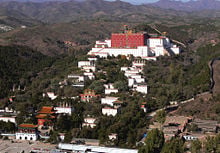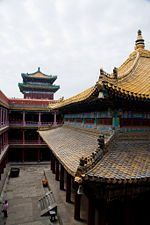Chengde Mountain Resort
| Mountain Resort and its Outlying Temples, Chengde* | |
|---|---|
| UNESCO World Heritage Site | |

| |
| State Party | |
| Type | Cultural |
| Criteria | ii, iv |
| Reference | 703 |
| Region** | Asia-Pacific |
| Inscription history | |
| Inscription | 1994 (18th Session) |
| * Name as inscribed on World Heritage List. ** Region as classified by UNESCO. | |
The Mountain Resort in Chengde (Chinese: 避暑山庄; pinyin: Bìshǔ Shānzhuāng; literally: Mountain Resort for Avoiding the Heat; Manchu: ![]() Halhūn be jailara gurung) or Ligong (Chinese: 离宫; pinyin: Lígōng, the Qing Dynasty's summer palace) situated in the city of Chengde in Hebei Province, China, is the world's largest existing imperial garden. In December 1994 the Mountain Resort was listed by UNESCO on its list of World Heritage Sites.
Halhūn be jailara gurung) or Ligong (Chinese: 离宫; pinyin: Lígōng, the Qing Dynasty's summer palace) situated in the city of Chengde in Hebei Province, China, is the world's largest existing imperial garden. In December 1994 the Mountain Resort was listed by UNESCO on its list of World Heritage Sites.
Built between 1703 and 1792, the Mountain Resort took 89 years to complete. It covers a total area of 5.6 km², almost half of Chengde's urban area. It is a vast complex of palaces and administrative and ceremonial buildings. Temples of various architectural styles and imperial gardens blend harmoniously into a landscape of lakes, pastureland and forests. In addition to its aesthetic interest, the Mountain Resort is a rare historic vestige of the final development of feudal society in China.
The Kangxi, Qianlong and Jiaqing Emperors often spent several months a year here to escape the summer heat in the capital city of Beijing and the palace zone in the southern part of the resort was therefore designed to resemble the Forbidden City in Beijing. It consists of two parts: a court in front, where the emperor received high officials, nobles of various minority nationalities, and foreign envoys; and bed chambers in the rear, which were the imperial family's living quarters.
True to its name, the Mountain Resort is known to be at least 3 degrees Celsius cooler than Chengde City itself.
Scenic spots
The Mountain Resort is most famous for the 72 scenic spots which were named by the Kangxi and Qianlong Emperors. Many of the scenic spots around the resort's lake area were copied from famous landscaped gardens in Southern China. For instance, the main building on Green Lotus Island, "Tower of Mist and Rain," (Chinese: 烟雨楼; pinyin: Yānyǔ Lóu) is a copy of a tower in Nanhu Lake at Jiaxing in Zhejiang Province. The resort's plain area also possesses characteristics of the scenery of the Mongolian grasslands. Forested mountains and valleys are dotted with various buildings. This includes a 70 m tall stone Chinese pagoda built in the year 1751 during the reign of the Qianlong Emperor. The pagoda is shaped with an octagonal base, while the pagoda's nine stories are decorated with colorful glazed tiles and the steeple is crowned with a gilded round spire.
Gallery
Outlying Temples
Putuo Zongcheng Temple

The Putuo Zongcheng Temple (Chinese: 普陀宗乘之庙; pinyin: Pǔtuó Zōngchéng) of Chengde, Hebei province, China is a Qing Dynasty era Buddhist temple complex built between 1767 and 1771,[1] during the reign of the Qianlong Emperor (1735-1796). It is located near the Chengde Mountain Resort, which is south of the Putuo Zongcheng. Along with the equally famed Puning Temple, it is one of the Eight Outer Temples of Chengde. The temple was modeled after the Potala Palace of Tibet, the old sanctuary of the Dalai Lama built a century earlier.[1][2] Hence the Putuo Zongcheng has been nicknamed the "Little Potala Palace". Since it was modeled after the Potala palace, the temple represents a fusion of Chinese and Tibetan architectural styles. The temple complex covers a surface area of some 220,000 square meters, making it one of the largest in China. Many of its halls and pavilions are adorned with copper and gold tiled roofs, adding to the splendor of the site.
History
The Putuo Zongcheng Temple is part of the "Eight Outer Temples" located in Chengde, which are part of the World Heritage List along with Chengde's Mountain Resort. These temples were administered by the "Lifan Yuan", an administrative department for the affairs of ethnic minorities such as the Mongolians and Tibetans, hence the different combinations of architectural style which could be seen throughout these Eight Outer Temples in Chengde.
The Putuo Zongcheng Temple was originally dedicated to Qianlong in order to commemorate his birthday, as well as provide Hebei with a temple of equal size and splendor as the Tibetan Potala Palace. The Putuo Zongcheng temple served more functions than just Buddhist ceremony and festival, however. It was also the location that the emperor would gather meetings of different ethnic envoys found throughout the empire. The location served as a peaceful getaway in contrast to the bustling life of the capital Beijing, as well as complimented the nearby hunting grounds that the emperor would enjoy with his hosts.
As of 1994, the Chengde Mountain Resort and Chengde's Eight Outer Temples (including the Putuo Zongcheng Temple) were established as UNESCO World Heritage Sites. Today, the temple remains a site of tourism and local festivities.
Gates, halls, and towers
Puning Temple
See also
- List of Buddhist temples
Notes
ReferencesISBN links support NWE through referral fees
- Foret, Philippe. (2000). Mapping Chengde: The Qing Landscape Enterprise. Honolulu: University of Hawaii Press. ISBN 0-8248-2293-5 (Paperback).
- Hevia, James Louis. "World Heritage, National Culture, and the Restoration of Chengde." positions: east asia cultures critique 9, no. 1 (2001): 219-43.
- Hedin, Sven and Bergman, Folke: History of the expedition in Asia 1927-1935, in: Reports from the scientific expedition to the north-western provinces of China under leadership of Dr. Sven Hedin. The sino-swedish expedition. Publication 24: Part II 1928–1933. Stockholm 1943-1945, page 121ff. and page 184ff.. See also: Sino-Swedish Expedition of Sven Hedin and the Century of Progress Exposition in Chicago 1933/1934 (german).
- Montell, Gösta: The Lama Temple Potala of Jehol. Plan of the Monastery-Ground. In: Geografiska Annaler, Band 17, Supplement: Hyllningsskrift Tillagnad Sven Hedin (1935), S. 175-184. (Putuo Zongcheng Temple)
- Montell, Gösta, Hedin, Sven: The chinese lama temple Potala of Jehol. Exhibition of historical and ethnographical collections. Made by Dr. Gösta Montell, member of Dr. Sven Hedin's Expeditions, and donated by Vincent Bendix. Chicago: Century of Progress Exposition 1932.
- Rawski, Evelyn Sakakida. (1998). The Last Emperors: A Social History of Qing Imperial Institutions. Berkeley: University of California Press. ISBN 0-520-22837-5 (Paperback).
External links
- Chengde at Archers Direct. Retrieved October 6, 2008.
- Travel China Guide. Retrieved October 6, 2008.
- World Heritage Virtual Tour (360 degree "panographic" view). Retrieved October 6, 2008.
- World Heritage Virtual Tour (360 degree "panographic" view; second view). Retrieved October 6, 2008.
| |||||||
Credits
New World Encyclopedia writers and editors rewrote and completed the Wikipedia article in accordance with New World Encyclopedia standards. This article abides by terms of the Creative Commons CC-by-sa 3.0 License (CC-by-sa), which may be used and disseminated with proper attribution. Credit is due under the terms of this license that can reference both the New World Encyclopedia contributors and the selfless volunteer contributors of the Wikimedia Foundation. To cite this article click here for a list of acceptable citing formats.The history of earlier contributions by wikipedians is accessible to researchers here:
The history of this article since it was imported to New World Encyclopedia:
Note: Some restrictions may apply to use of individual images which are separately licensed.














